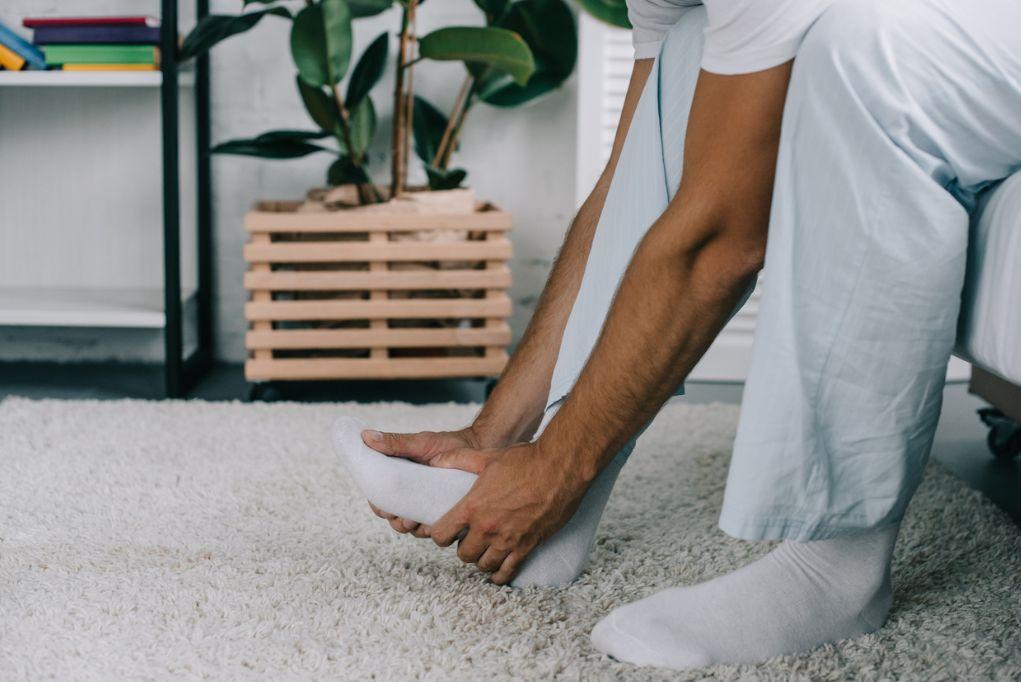Causes of Hip Pain When Walking and How to Treat Them
Walking should be one of the most natural, effortless movements we do every day. But when hip pain when walking turns each step into a struggle, even simple activities like grocery shopping, walking the dog, or moving around your home can become uncomfortable or downright painful.
Hip pain during walking is more common than you might think, affecting people of all ages and activity levels. The causes can range from overuse and muscle strain to arthritis and structural problems within the joint.

How the Hip Functions
The hip joint is one of the largest and most important joints in your body. It’s a ball-and-socket joint where the rounded top of your thighbone (femur) fits into a cup-shaped socket in your pelvis. This design allows for a wide range of motion while supporting your body weight during standing, walking, and running.
When you walk, your hip joint absorbs significant force with each step, sometimes up to five times your body weight when walking briskly or on an incline. The joint is surrounded by muscles, tendons, ligaments, cartilage, and fluid-filled sacs called bursae that work together to provide stability, cushioning, and smooth movement.
Hip pain when walking can develop gradually over time or appear suddenly after an injury. The pain may be felt in different areas depending on the underlying cause, including the front of the hip or groin, the side of the hip, the buttock, or even radiating down the thigh.
Common Causes of Hip Pain When Walking
1. Hip Osteoarthritis
Osteoarthritis is the most common cause of hip pain in adults, particularly those over 50. This “wear and tear” arthritis occurs when the protective cartilage that cushions the hip joint gradually breaks down, causing bone-on-bone friction.
Signs of Hip Osteoarthritis:
- Dull, aching pain in the groin, outer hip, or buttock
- Stiffness, especially in the morning or after sitting
- Pain that worsens with activity and improves with rest
- Reduced range of motion
- Grinding or clicking sensation in the hip
2. Hip Bursitis (Trochanteric Bursitis)
Bursitis occurs when the bursa, a small fluid-filled sac that cushions the hip joint, becomes inflamed. Trochanteric bursitis affects the bursa on the outer side of the hip and is particularly painful when walking, climbing stairs, or lying on the affected side.
Signs of Hip Bursitis:
- Sharp or burning pain on the outer hip
- Tenderness when touching the side of the hip
- Pain that spreads down the outer thigh
- Increased discomfort after prolonged walking or standing
- Difficulty sleeping on the affected side
3. Hip Labral Tear
The labrum is a ring of cartilage that lines the hip socket, providing stability and cushioning. A tear in this cartilage can cause catching, locking, or a sharp stabbing sensation during walking, especially when pivoting or changing direction.
Signs of a Hip Labral Tear:
- Sharp pain in the groin or front of the hip
- Clicking, locking, or catching sensation
- Limited range of motion
- Pain with twisting or pivoting movements
- Feeling of instability in the hip
4. Hip Flexor Strain
The hip flexor muscles, located at the front of the hip, lift your leg with each step. Overuse, sudden movements, or insufficient warm-up can strain these muscles, causing pain that worsens with walking, especially when lifting the knee.
Signs of Hip Flexor Strain:
- Pain in the front of the hip or groin
- Discomfort when lifting the knee or flexing the hip
- Tenderness or cramping in the upper thigh
- Reduced strength when walking uphill or climbing stairs
- Swelling or bruising in severe cases
5. Tendinitis
Hip tendinitis involves inflammation of the tendons that connect muscles to bones around the hip. The most common types are iliopsoas tendinitis (front of the hip) and gluteal tendinitis (side or back of the hip).
Signs of Hip Tendinitis:
- Gradual onset of pain that increases with activity
- Tenderness along specific tendons
- Pain with specific movements like climbing stairs or getting out of a car
- Morning stiffness that improves with gentle movement
6. Sciatica
While sciatica originates in the lower back, it often causes hip pain when walking. The sciatic nerve runs from the lower spine through the buttock and down the leg. When compressed or irritated, it can create radiating pain felt in the hip area.
Signs of Sciatica:
- Shooting or burning pain from the lower back through the hip and leg
- Numbness or tingling in the leg or foot
- Weakness in the affected leg
- Pain that worsens when sitting or standing from a seated position
7. IT Band Syndrome
The iliotibial (IT) band is a thick band of tissue that runs along the outside of the thigh from the hip to the knee. When tight or inflamed, it can cause pain on the outer hip and thigh during walking or running.
Signs of IT Band Syndrome:
- Pain on the outside of the hip or thigh
- Discomfort that increases with distance walked
- Clicking or popping sensation on the side of the hip
- Pain when walking downhill or on uneven surfaces
8. Hip Impingement (Femoroacetabular Impingement)
Hip impingement, or FAI, occurs when extra bone growth on the femur or hip socket causes abnormal contact between these bones during movement. This can lead to pain and limited motion, particularly during walking and activities requiring hip flexion.
Signs of Hip Impingement:
- Deep, aching pain in the groin
- Stiffness and reduced flexibility
- Pain that worsens with prolonged walking or sitting
- Difficulty with activities requiring hip bending
9. Stress Fracture
Repetitive impact from activities like running or sports can cause small cracks in the hip bone, known as stress fractures. These typically develop gradually and cause significant pain with weight-bearing activities.
Signs of a Stress Fracture:
- Deep, aching pain in the groin or hip
- Pain that worsens with walking and improves with rest
- Tenderness when pressing on the affected area
- Limping or altered gait to avoid pain
10. Muscle Imbalances and Weakness
Weakness in the hip abductors, glutes, or core muscles can alter your walking mechanics, placing extra stress on the hip joint and surrounding structures. This often leads to pain that develops over time.
Signs of Muscle Imbalance:
- Hip pain that develops gradually without clear injury
- Pelvic drop or hip hiking when walking
- Lower back pain accompanying hip discomfort
- Fatigue in the hip or leg muscles during walks
Where You Feel Hip Pain Matters
The location of your hip pain when walking can provide important clues about the underlying cause:
- Front of hip or groin: Often indicates hip arthritis, labral tear, hip flexor strain, or hip impingement
- Outer hip: Commonly associated with bursitis, IT band syndrome, or gluteal tendinitis
- Back of hip or buttock: May suggest sciatica, piriformis syndrome, or sacroiliac joint dysfunction
- Radiating down the leg: Could indicate sciatica, referred pain from the lower back, or nerve compression
Pay attention to when the pain occurs, what movements make it worse, and any associated symptoms like stiffness, swelling, or weakness.
When to See a Doctor for Hip Pain When Walking
While mild hip discomfort may improve with rest and home care, certain symptoms warrant prompt medical evaluation:
- Severe pain that prevents you from bearing weight or walking normally
- Sudden onset of hip pain after a fall, accident, or injury
- Swelling, warmth, or redness around the hip joint
- Hip pain accompanied by fever, which could indicate infection
- Pain that persists for more than a few weeks despite rest and over-the-counter treatments
- Locking, catching, or giving way sensations in the hip
- Numbness, tingling, or weakness in the leg
- Difficulty with daily activities like getting dressed, climbing stairs, or getting in and out of a car
Early diagnosis and treatment can prevent minor issues from becoming chronic problems and help you maintain mobility and quality of life.
Treatment Options for Hip Pain When Walking
Treatment for hip pain when walking depends on the underlying cause, severity of symptoms, and your overall health. Most conditions respond well to conservative care, though some may require more advanced intervention.
Conservative Treatments
Rest and Activity Modification
Reducing or modifying activities that trigger hip pain gives inflamed tissues time to heal. This doesn’t mean complete bed rest, but rather avoiding movements that worsen symptoms while staying gently active in ways that don’t cause pain.
Ice and Heat Therapy
Apply ice for 15–20 minutes several times daily during the first few days after pain begins to reduce inflammation. After the initial period, heat therapy can help relax tight muscles and improve blood flow to the area.
Physical Therapy
Physical therapy is often the cornerstone of treatment for hip pain when walking. A skilled therapist will create a customized program that may include:
- Stretching exercises to improve flexibility in tight hip muscles
- Strengthening exercises for the hip, core, and leg muscles
- Gait training to correct walking mechanics
- Manual therapy techniques to reduce pain and restore mobility
- Balance and stability training
Anti-Inflammatory Medications
Over-the-counter NSAIDs like ibuprofen or naproxen can help manage pain and reduce inflammation. Your doctor may prescribe stronger medications if needed.
Weight Management
For those carrying extra weight, losing even a modest amount can significantly reduce stress on the hip joints and decrease pain during walking.
Supportive Devices
Depending on the cause and severity of your hip pain, your doctor may recommend:
- Walking aids like a cane or crutches to reduce weight-bearing stress
- Shoe inserts or orthotics to correct gait abnormalities
- Hip braces for additional support during healing
Advanced Treatment Options
Corticosteroid Injections
For persistent inflammation, particularly in cases of bursitis, arthritis, or tendinitis, a cortisone injection directly into the affected area can provide significant pain relief and reduce swelling. This allows you to participate more effectively in physical therapy.
Viscosupplementation
For hip osteoarthritis, injections of hyaluronic acid (a gel-like substance that mimics natural joint fluid) can help lubricate the joint and reduce pain.
Surgical Treatment
Surgery is considered when conservative treatments haven’t provided adequate relief after several months, or when there’s significant structural damage. Surgical options include:
- Hip arthroscopy: Minimally invasive procedure to repair labral tears, remove loose cartilage, or treat hip impingement
- Hip replacement: For advanced arthritis where the damaged joint is replaced with an artificial implant
- Fracture repair: Surgical stabilization of hip fractures with plates, screws, or rods
- Bursectomy: Removal of chronically inflamed bursa that doesn’t respond to other treatments
Modern surgical techniques, including minimally invasive approaches, offer faster recovery times and excellent outcomes for patients who need them.
Living with Hip Pain: When to Modify Activities
If you’re experiencing hip pain when walking, you don’t necessarily have to stop moving altogether. In fact, complete inactivity can lead to stiffness and weakness that makes the problem worse. Instead, consider these modifications:
- Switch to low-impact activities like swimming, water aerobics, or stationary cycling
- Walk on flat, even surfaces rather than hills or uneven terrain
- Take shorter, more frequent walks instead of one long walk
- Use walking poles to distribute weight and improve stability
- Walk at a comfortable pace without pushing through significant pain
- Incorporate rest breaks during longer outings
The goal is to stay active while allowing your hip to heal and avoiding movements that aggravate your condition.
Expert Hip Care at Motion Orthopaedics
Hip pain when walking doesn’t have to be something you just live with. At Motion Orthopaedics, our experienced orthopedic specialists understand how debilitating hip pain can be and how it affects your ability to enjoy daily life. We’re committed to finding the root cause of your pain and developing a treatment plan tailored to your specific needs and goals.
Whether you’re dealing with arthritis, a sports injury, or chronic hip discomfort, our team combines advanced diagnostic capabilities with both conservative and surgical treatment options to help you get back to pain-free walking.
Meet Our Hip Specialists:
- David J. King, MD, is a board-certified orthopedic surgeon specializing in hip pain as well as knee, shoulder, elbow and ankle injuries. Click here to learn more about Dr. King.
- Scott W. Zehnder, MD, is a board-certified orthopedic surgeon who is fellowship trained in orthopedic sports medicine. Click here to learn more about Dr. Zehnder.
Get Relief from Hip Pain in Missouri
Don’t let hip pain keep you from staying active and enjoying the activities you love. Whether you’re experiencing sharp, shooting pain or a persistent ache that’s making every step uncomfortable, the orthopedic specialists at Motion Orthopaedics can help you find lasting relief.
With convenient locations across Missouri, including Creve Coeur, Wentzville, and surrounding communities, expert hip care is always within reach.
Contact Motion Orthopaedics today to schedule an appointment and take the first step toward pain-free walking and improved hip health.




